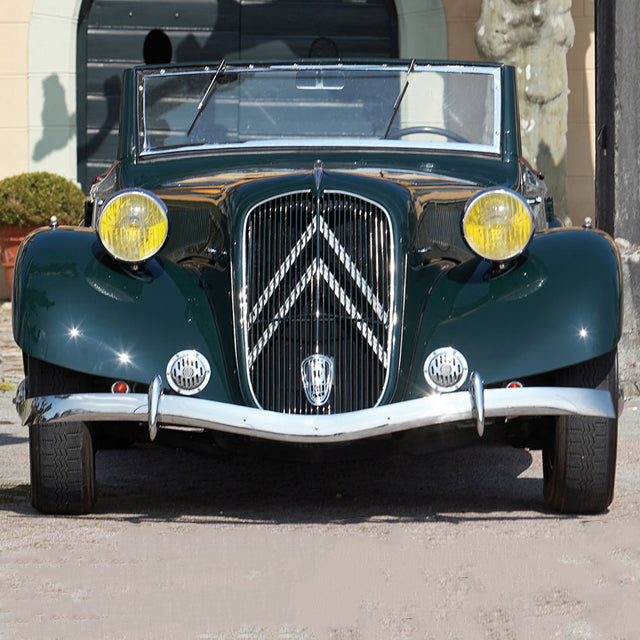The estimate for this RM Sotheby’s lot stretches past a million Euros, which places it in serious company among collectible classics. Some of you may comment that the amount will buy a great classic Ferrari, or a garage full of new Porsches, or a container ship full of Honda Groms—just as long as it’s not spent on a front-wheel-drive Art Deco Roadster from France.
“Would you buy it?” is not a very important question—the car will surely outlive its next few owners—but why is its estimate so high? It’s been repainted over the years, has a reported 74 horsepower, and drum brakes at all four wheels: three details that should send some cognoscenti running for the closest Italian barchetta.
To start, at the very least, you can be assured that some of the most influential automotive engineers had a hand in its construction.

There were two-rows-of-seats Traction Avant convertibles built before the Second World War, yes, but this particular car is a 1939 “Roadster”, designed for two occupants. Here, the occupants were Anna Michelin and whomever she wanted. She’d been widowed two years earlier when her 34-year-old husband Pierre Michelin (who was a son to the company’s founder, Édouard), flew off the road—black ice and, likely, excessive speed are said to have been factors in his death.
Not only was he the heir to France’s growing industrial empire, Michelin, but he was also the President of Citroën—Michelin having settled Citroën’s debts in 1935, taking the automaker in hand. Pierre was lucky to have some of the world’s best minds at the company, and he encouraged visionaries like André Lefèbvre, Pierre-Jules Boulanger, Flaminio Bertoni, and Paul Magès to push vehicle design forward.
Their brilliance creates a problem for me, actually, because to give you an accurate picture of the vehicles they had a hand in making (and the technology on your car today because of them), the story will cease to be about this particular 1939 Citroën 15 CV “Traction Avant” Roadster. Besides the cars, including the Traction Avant, 2CV, DS, HY van, SM, and Ami 6, you must also consider the world-first technology that each of those models brought to market. Thinking about all that will make your brain hurt—it’s easier and more fun to read this book. (I bought a copy with my own money years ago, because who doesn’t want a book about old French cars on the shelf?)
Anyway, one of my favorite things about Citroën’s dream team of designers is how much of automotive history they helped to indirectly create.
For instance, one of the best Traction Avant facts to recite at your local Cars & Coffee is that the car’s revolutionary design was, in part, directly responsible for Cooper’s place in history as the first race-winning mid-engined car in Formula 1, and later, the first constructor with a mid-engined car to win the World Championship. Eh? Turns out that the Traction Avant’s (front-drive) cast aluminum transaxle was the only part suitable when John Cooper and Owen Maddock created their groundbreaking F1 car, the T43. Sir Stirling Moss notched its first win in the 1958 Argentine Grand Prix. A tangent, sure—Cooper’s indirect racing success isn’t a great reason to bid on this car—so what do we know?
The Roadster was designed to be the top model in the company’s range, with the largest 74 hp six-cylinder engine fitted, a longer hood, and that svelte two-passenger cabin. This car, chassis no. 680 959, is the first of four Roadsters constructed—as authenticated by Citroën Heritage—and the only survivor from a planned run of five.



Forgive yourself for not knowing that these cars existed: the Roadster was never publicly shown, owing to the outbreak of the Second World War. As such, it didn’t leave the “family” until 1951: Anna Michelin used the car, which was also equipped with a rear armrest, more capacious glovebox, larger fuel tank, and trafficator signals, as her daily driver. After it was sold on, its new owner treated the car to a repaint before an American enthusiast purchased the car in 1954.
Through a string of owners over the next few decades, this car has been repainted, updated, and restored. Its next buyer will appreciate that it retains its original engine, and that it’s arguably in its most original state since the engineers at Citroën decided to make a sporting, top-of-the-line Roadster from their Traction Avant.
All of this is to say: every highly-valued classic is different. In the case of this Citroën, the car’s next steward will be buying not only the metal—but a helluva story to tell about the woman it was built for. Hopefully, its owner will also memorize a few anecdotes about this Roadster’s creators.
History
–Originally delivered to Mrs Anna Michelin
–The first of four 15 CV Roadsters built
–The only surviving example verified built by the factory
Specifications
~74 horsepower, 2,867 cc OHV inline six-cylinder engine, three-speed manual transmission, independent front torsion bar suspension, solid rear axle suspension, and four-wheel drum brakes. Wheelbase: 3,087 mm
Vehicle information
Chassis no. 680 959
Engine no. PD 00195
Body no. EE 0016
Valuation
–Includes Citroën Heritage certificate
–Auction house: RM Sotheby’s
–Estimate: €650,000–€1,100,000
–Price realized: TBD; Auction on May 14























































